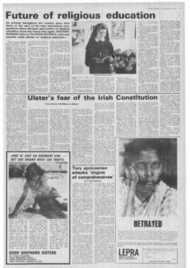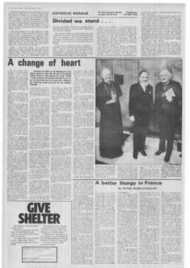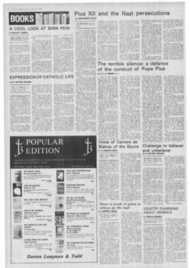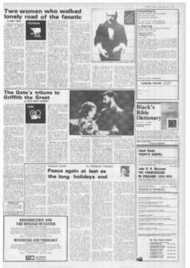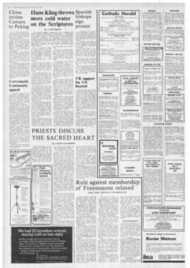Page 6, 27th September 1974
Page 6
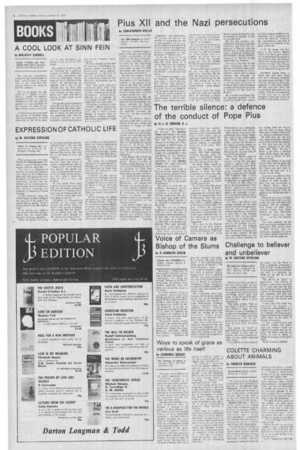
Report an error
Noticed an error on this page?If you've noticed an error in this article please click here to report it.
Tags
Share
Related articles
Nazi Camps
Vatican Dismisses Writer's Attack On Pope Pius Xii
Secret Papers Vindicate Pope Pius Xii, Says Jewish Scholar
By Fr Tim Finigan
Pius' Silence Hid Perils
The terrible silence: a defence of the conduct of Pope Pius
by Fr J. H. CREHAN, S. J.
Under the title "The terrible silence" the Sunday Times published a full-page attack (August 28) on Pope Pius XII for his alleged silence in the face of a Nazi campaign to rid Germany of mental defectives and the physically handicapped who could not contribute to the well-being of the German People. What follows was submitted to the 'Sunday Times hut was refused publication as a let:er.
As a Jesuit who lived in Munich in 1931, before Hitler came to power, perhaps I may be allowed a brief comment on what Miss Sereny had to say against Pius XII on the matter of euthanasia.
She seems to think that an academic theological opinion compiled by Josef Mayer somehow convinced the Catholic authorities that they must hold their hand before condemning Hitler's murder of the mentally or physically handicapped.
She does not cite Cardinal Faulhaber's Lenten Pastoral of 1934, in which the idea of euthanasia, based on the principle that what is for the benefit of the people as a whole is morally right, was roundly condemned, This same principle was again condemned, and more loudly, by Pius X1 in 1938.
The Nazi practice of euthanasia was in full swing in October 1939. but covertly. Relatives were told that the dear one in the asylum had died from a heart attack, and no questions could be asked. The time-table of protest from the German bishops is somewhat different from what Miss Sereny says. They met at Fulda, 20-22 August 1940. Their chairman, Cardinal Bertram, signed his report, 8 September. Bishop Berning travelled to Rome and saw Pius XII on 14 October.
The Holy Office issued its decree 27 November. This said that direct killing by public authority of those who have committed no crime but who, from mental or physical incapacity are unable to benefit the state, is against the divine and the natural law.
On 15 December Pius wrote to Bishop Preysing of Berlin: "About the distressing happenings that were the object of that courageous letter from Wurttemberg, there has gone out in the meantime from the Holy Office a public judgment on the matter of principles. We have enabled our supreme Tribunal to speak as briefly and to the point as was possible. We would have believed that we were failing in our duty if we had been silent over such happenings.
"It is now for the German bishops to sec what circumstances require to be done in
each local situation." (The allusion to a letter from Wurttemberg was a safeguard, in case the letter went astray).
Miss Sereny has drawn her information from former Nazis. She ought to have told readers that Albert Hard, a lapsed priest, accused the Rector of the minor seminary (where he was a Prefect or usher) of having said at table that the Reichstag fire was the work of the Nazis themselves.
When the Rector came to trial, Hartl was already a member of the S.S. and gave evidence against him. Miss Sereny claims that Josef Roth, "was still a priest when these events occurred", but she has failed to notice that on 9 March 1939 Faulhabcr said: "I have never replied to any piece of writing that was signed ROTH. "I wrote to this effect to Kerrl, the Reichsminister. Now Roth's signature does not appear any more. It would be against my principles to conduct any correspondence with a diocesan priest who was in his situation."
At that time Roth was already working for the Nazi ministry of cults and against the Church. Since the other witness, Josef Mayer, was found to have lied to the German courts in 1967, it is not much use relying on his testimony.
Miss Sereny can have little idea of the problem of communication for the Catholic bishops of Germany in those days. My friend, Fr Konig, was one of their couriers. He had been ordained before the war, but with a heart condition he was exempt from war service and was able to move about from place to place in his small car, taking confidential letters.
He died after the war was over, from exhaustion. Another priest whom I knew as a student in 1931 had been one of the earliest members of the Nazi party. Max Hahn. He was a boxer at the circus in Munich where Hitler began his party, and used to listen to him between bouts.
After the failure of the first Putsch, Hahn left the party and became a priest. In 1939 he left the Church and went back to the party. He died later, of a tumour on the brain.
These two very different men of the German clergy may be symbolic of wider circles. A third type was represented by Fr Rupert Mayer, whom I listened to as he denounced the Nazi "false prophets" from the pulpit of the Michaelskirche in Munich.
When the war came, he said: "It is a dreadful thing to say, but in this war one must hope that Germany will be defeated." One heard the Nazi mob singing: "Juden raus, Papst hinaus, aus dem deutschen Vaterhaus." (Jews out, Pope out . . out from the German home.)
The "final solution" for the Jews was already decided on by September 1939, and the thesis of Miss Sereny, that the euthanasia campaign was a trial trip, before hands were laid on the Jews, will not stand up.
blog comments powered by Disqus




